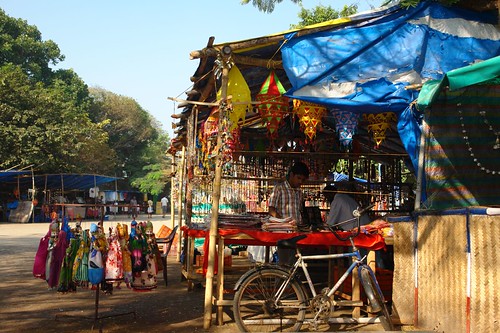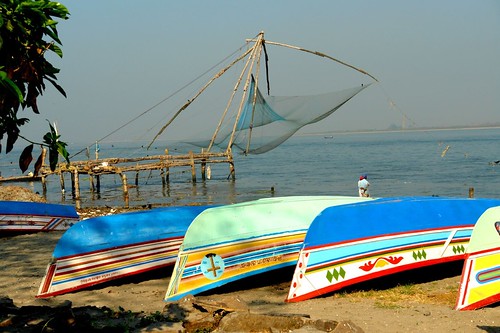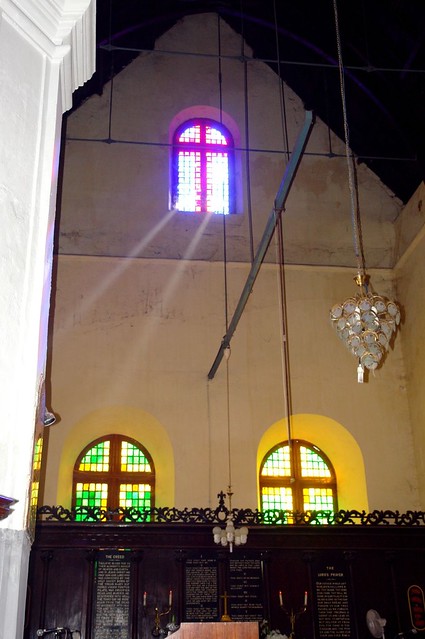Cochin has not changed a bit in all the years that I have been going there on work. True, the airport is larger, glitzier and farther than it used to be ten years ago. There is more chrome and glass all over the city, Subways and Coffee Days alongside the Dwarakas and smaller eating places of old. Mammooty and Mohanlal beam at you alternately from all the hoardings in the city. And then suddenly, near the old airport area, there is a faded hoarding with Amitabh Bacchan with a – do not throw your garbage out into the open. Why, I wonder…
I had a few hours in the morning before my flight to Bombay and I decided to explore the Fort Kochi area; the weather was cool by Kerala standards and I had a car with Jomon the driver eager to double up as local guide and broken-Tamil translator. We crossed many bridges, most of them built recently to make local it easier to travel through Cochin, with its many tiny islands now part of the main city. We then drove through narrow lanes, romba neraiyya humbu – too many humps – speedbreakers – on the road because of schools in the area, Jomon informed me seriously. Road humps notwithstanding, we narrowly missed being run down by a bus headed towards navel base at breakneck speed.
Fort Kochi could be charming; centuries of history and culture squeezed tight within a few square kilometers of narrow lanes all leading to the sea. Now there is garbage all over, there is kitsch all the way from Rajasthan, there is the dust and mud of of construction.
Empty coconut shells lie strewn all over the place, alongside lie empty boats, colorful in their fresh coats of paint but looking tired and just wanting to sleep through the heat of the day… Local guides take groups of foreigners around relating tales of the portugese and the chinese that sound too rehearsed to be true. Fishermen wait for foreigners to walk up to them before they start operating their fishing nets; only two hundred rupees madam, one of them told me, offering me a “dicsount rate” in honor of my Tamil.
Despite all this, Fort Kochi is charming. Just as you get off the car at the Vasco Da Gama (he is all over the place here), you catch sight of the chinese fishing nets waiting for you, waiting for the right tide to begin their descent into the sea. Picturesque and pretty, these nets which operate on a simple system, were brought all the way from China centuries ago. Many of them lie broken today, and my driver says that few local fishermen know how to repair them. Now they seem to act more as tourist traps rather than traps for fish.
Just down the road is St. Francis Church, built in 1503, some say by the Vasco man himself, definitely by the Portugese, in any case. The church is undergoing renovation work now, but despite the buzz of the cleaners and carpenters, there is a sense of peace and quiet inside. The high wooden ceilings and the brilliant stained glass have clearly withstood centuries of well-meaning renovation. On one side is a rectangle where Vasco Da Gama was said to be buried initially, before his remains were shipped off to Lisbon.
Just as I walk out of the church, a guide escorts a group of middle-aged English women, he leads them to a step where they can sit comfortably while removing their shoes. In India it is customary to remove shoes before entering any temple, he says in English that sounds more like Malayalam. It is amazing how India swallows up centuries of foreign influence, churches become temples and English is embraced in one fell swoop into the numerous local dialects and accents of the country.
My last stop was at the Dutch Palace, now also the local archaeological museum. The palace – museum, not as popularly mentioned as the fishing nets and the church, was a wonderful surprise. For an entry fee of Rs.2, I spent an hour gazing at the collection of arms and coins and palanquins, and more importantly the fascinating murals in the first floor and the basement (which is actually at ground level, but is reached by narrow steep steps from inside the museum). Most of the murals depict scenes and stories from the Ramayana. there is also one entire blank wall in the basement, where there was at some time in the past, murals depicting the entire Kumarasambhava by Kalidasa. It has now been sketched in black and displayed along with the information board.
The murals were breath-taking in their detail, with their rich vermillons and vibrant ochres and deep reds of vegetable dyes. The blues and indigos, so much a feature of mural work in the North, especially that associated with Rajasthan, were prominently missing here; only one solitary figure of Vishnu carried dark greens, which seemed too fresh to have been painted centuries ago. The basement also had an inside room filled with what can only be described as the Kamasutra of the gods; siva playing with vishnu-maya, parvati looking on in anger and envy in one; siva playing with parvati herself, seated on his lap, in another. Krishna in rasa leela, the gopis dancing intoxicated by love and lust for him.
The huge compound also contains a temple of the bhagavati, the protector deity of the rajas. The palace was built and presented by the Portugese to the Raja of Kochi, Vira Kerala Varma in 1555 AD. It came to be known as the Dutch Palace from 1663 after they carried out some renovations in the palace.
In all, a couple of hours well spent. Fort Kochi has more, notably the famous Jew Town, also home to the oldest Synagogue in the country, built in 1568. I intend to visit it the next time I am in Cochin. And also wait patiently to watch the chinese nets in action. Trapping fish and tourists alike cleverly.








Enjoyed reading your post on West Kochi – especially Fort Kochi where I studied school for 12 years. These days, like you said it’s become more ‘touristy’ and dirty. The part of Kochi you mentioned, where the synagogue and Jew Town and Dutch Palace is, is called Mattancherry and is not a part of Fort Kochi. I lived in Mattancherry for 23 years of my life and I feel ‘proud’ whenever I hear of the place!
It is always wonderful to see things in a different perspective. I enjoyed reading your post
I live in Fort Cochin and I am a Tour Operator based at Ernakulam.
There are more things that you could explore at Fort Cochin and Mattancherry
Mattancherry is a Cultural Hub. Where you could find 13 different communities, speaking thirteen different languages, worshiping thirteen different Gods. They had been living in harmony for centuries. I think it is wonderful to live in a place which practices religious tolerance for centuries.
Please do visit Cochin again
I am visiting Kochi in Sept! Looking forward to seeing all the places you mentioned in fort Kochi area